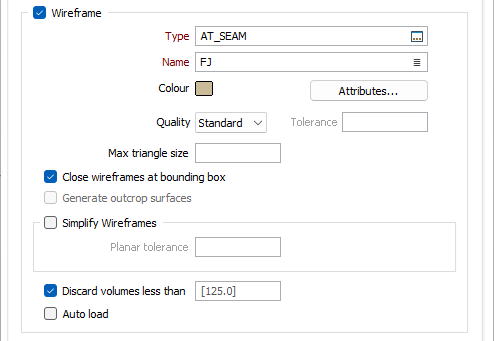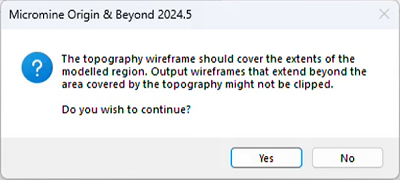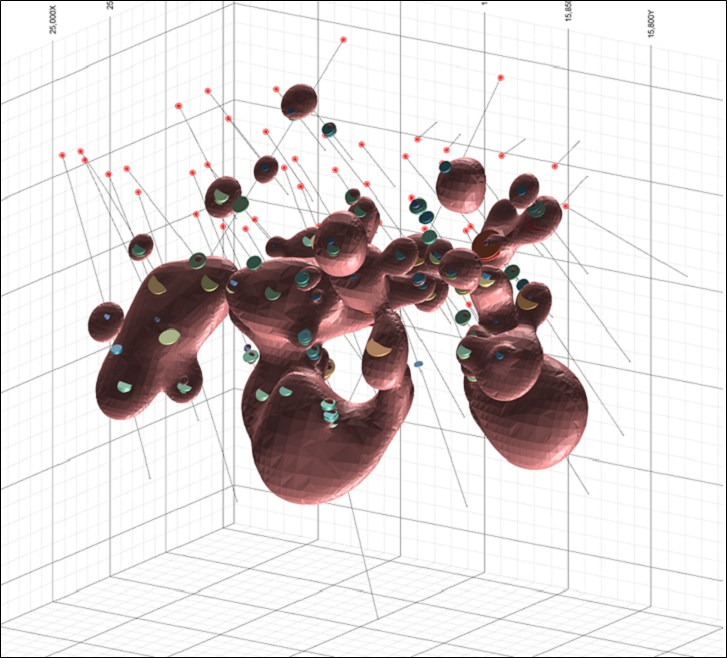Output
On the Output tab of the form, specify the Iso Value and configure any required details for Wireframe, Volume and Output options.
Iso Value
The Iso value controls how the surface fits between points.
Iso
Enter the Iso surface value used for the Wireframe and Volume outputs for the indicator model in the field provided.
The values for this field are restricted between 1 and 0. The higher the value, the more constrained the wireframe is. When the value is lower, the wireframes tend to “inflate” slightly and include more “waste”. The default value is 0.5, which represents the mid surface.

Wireframe
Select the Wireframe check box to enable the generation of wireframe outputs for the Indicator model.
Type
Double click (F3) in the Type field or use the Select icon to select the wireframe type for the output. If necessary, you can right-click (F5) and select the option to create a New Type.
Name
Double-click (F3) in the Name field to select a wireframe of the chosen type.
Colour
The Colour option is used to select the display colour for the output. Double click the Colour box and select a colour from the Colour Selection dialog.
Attributes
The Attributes button opens the Wireframe Properties form used to optionally configure details for the output wireframes. See Wireframe Attributes
Quality
This setting provides a convenient way to control the quality and the speed of wireframe generation. There are five quality settings: Draft, Standard, High, Ultra and Custom.

Setting the quality to Draft allows the general shape of the output wireframes to be generated quickly.
With the exception of Custom, each quality setting has a pre-set error tolerance value. The error tolerance for Draft is approximately twice that for Standard, which, in turn, is twice that for High, etc.
Setting the Quality to Custom allows a user-specified error tolerance. There is no limit to the user-specified error tolerance value (and hence the minimum mesh size), other than that imposed by available system memory.
Tolerance
Specify a tolerance (in Grid units) where Custom wireframe Quality has been selected.
Max triangle Size
To eliminate large meshes, specify a Maximum Triangle Size parameter in grid units.
By default, mesh size is controlled by the tolerance parameter, which specifies the maximum error between the rendered surface and the actual surface. Typically, larger meshes are used where the surface is relatively flat, and smaller meshes are used where the surface has high curvature.
If a Max Triangle Size is specified then all triangles will be that size, or smaller if they fail the tolerance test.
Close wireframes at bounding box
If this option is selected, the wireframe
Generate outcrop surface
If Topography generation has been configured, you can select the Generate outcrop surface/s option to create outcrop surfaces for the output.
Simplify Wireframes
Select this option to reduce the number of vertices in the triangulation by eliminating those points that can be removed without causing the triangulation to move by more than the specified tolerance values:
- Planar Tolerance. This is the maximum amount that the triangulation is allowed to move in any direction after vertices are removed.
If no planar tolerance is specified, a default value of 0.01 will be applied automatically. Specifying a large planar tolerance will significantly alter the nature of the triangulation.
Discard volumes less than
If this option is selected, all independent triangle shells with a volume less than the specified minimum volume will be removed.
Any value less than or equal to zero will disable volume removal.
Auto load
Select this option to load the generated output in Vizex. The default draw style for an auto-loaded wireframe is 3D Shaded.

Volume
Select the Volume check box to enable the generation of Volume outputs for the Indicator model.
File
Double click (F3) in the File field or use the ellipsis to select the Volume file for the Indicator model output.
Granularity
The Granularity options are used to set the granularity of the physical properties of the Indicator implicit model. Use the X,Y,Z fields to enter the values for the coordinate directions or use the auto-calculated defaults function.
Auto load
Select this option to load the generated output in Vizex. The default draw style for an auto-loaded wireframe is 3D Shaded.
Palette
Where Auto load is selected, double click in the Palette box to select a colour palette for the output.

Output Files
Implicit Model
Enter (or click on the ellipsis button to select) the name of an implicit model output file.
Interpolated Points
Enter (or click on the ellipsis button to select) the name of a Points file. The interpolated points generated by the process will be written to this file

If the topograpy does not entirely cover the area covered by the bounding box, a warning prompt will appear.

Run
When you have configured the necessary options of the Indicator model, click Run to create the model.
